2007 CHEVROLET EXPRESS PASSANGER light
[x] Cancel search: lightPage 1 of 458

Seats and Restraint Systems
....................... 7
Front Seats
.............................................. 9
Rear Seats
............................................. 13
Safety Belts
............................................ 17
Child Restraints
...................................... 41
Airbag System
........................................ 78
Restraint System Check
......................... 98
Features and Controls
.............................. 101
Keys
..................................................... 102
Doors and Locks
.................................. 108
Windows
............................................... 115
Theft-Deterrent Systems
....................... 118
Starting and Operating Your Vehicle
..... 119
Mirrors
.................................................. 134
Storage Areas
...................................... 139
Instrument Panel
....................................... 141
Instrument Panel Overview
................... 144
Climate Controls
................................... 160
Warning Lights, Gages, and
Indicators
.......................................... 166
Audio System(s)
................................... 187Driving Your Vehicle
................................. 227
Your Driving, the Road, and Your
Vehicle
.............................................. 228
Towing
................................................. 266
Service and Appearance Care
.................. 287
Service
................................................. 290
Fuel
...................................................... 292
Checking Things Under the Hood
......... 300
All-Wheel Drive
..................................... 336
Rear Axle
............................................. 337
Front Axle
............................................ 338
Noise Control System
........................... 338
Bulb Replacement
................................ 340
Windshield Wiper Blade
Replacement
..................................... 344
Tires
..................................................... 346
Appearance Care
.................................. 382
Vehicle Identification
............................. 392
Electrical System
.................................. 393
Capacities and Specifications
................ 398
2007 Chevrolet Express Owner ManualM
1
Page 5 of 458
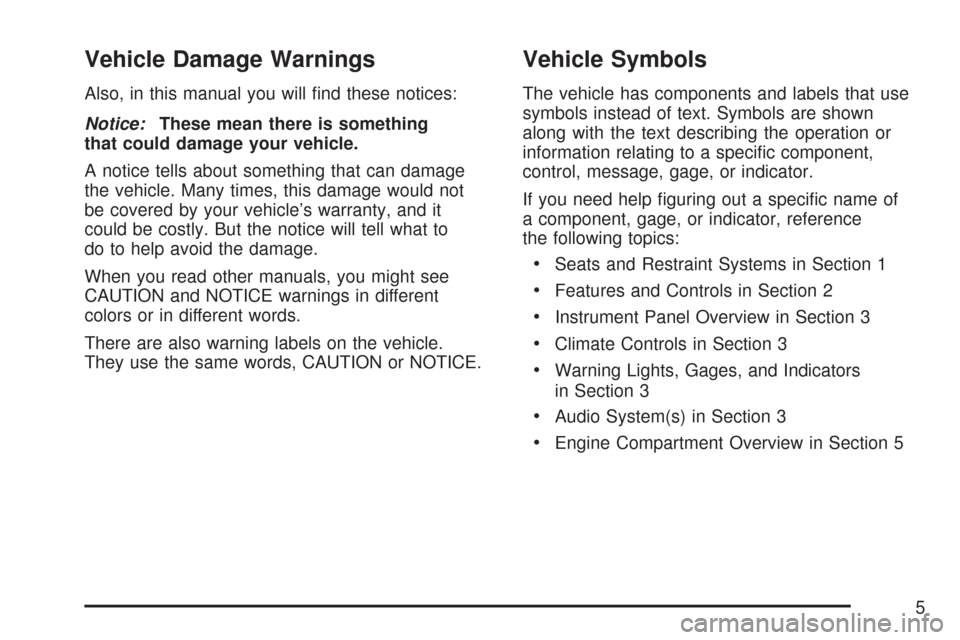
Vehicle Damage Warnings
Also, in this manual you will find these notices:
Notice:These mean there is something
that could damage your vehicle.
A notice tells about something that can damage
the vehicle. Many times, this damage would not
be covered by your vehicle’s warranty, and it
could be costly. But the notice will tell what to
do to help avoid the damage.
When you read other manuals, you might see
CAUTION and NOTICE warnings in different
colors or in different words.
There are also warning labels on the vehicle.
They use the same words, CAUTION or NOTICE.
Vehicle Symbols
The vehicle has components and labels that use
symbols instead of text. Symbols are shown
along with the text describing the operation or
information relating to a specific component,
control, message, gage, or indicator.
If you need help figuring out a specific name of
a component, gage, or indicator, reference
the following topics:
•Seats and Restraint Systems in Section 1
•Features and Controls in Section 2
•Instrument Panel Overview in Section 3
•Climate Controls in Section 3
•Warning Lights, Gages, and Indicators
in Section 3
•Audio System(s) in Section 3
•Engine Compartment Overview in Section 5
5
Page 17 of 458
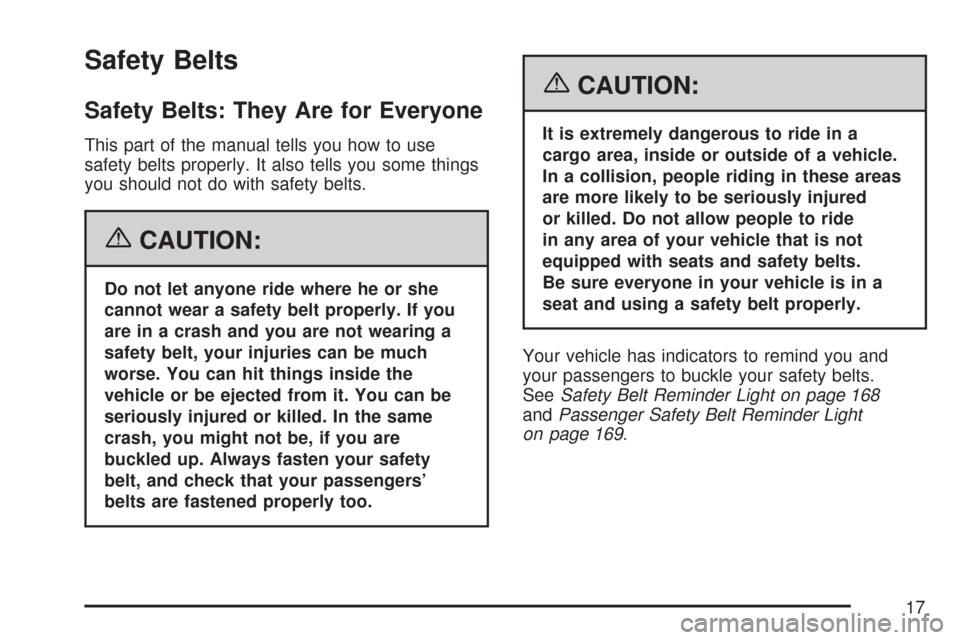
Safety Belts
Safety Belts: They Are for Everyone
This part of the manual tells you how to use
safety belts properly. It also tells you some things
you should not do with safety belts.
{CAUTION:
Do not let anyone ride where he or she
cannot wear a safety belt properly. If you
are in a crash and you are not wearing a
safety belt, your injuries can be much
worse. You can hit things inside the
vehicle or be ejected from it. You can be
seriously injured or killed. In the same
crash, you might not be, if you are
buckled up. Always fasten your safety
belt, and check that your passengers’
belts are fastened properly too.
{CAUTION:
It is extremely dangerous to ride in a
cargo area, inside or outside of a vehicle.
In a collision, people riding in these areas
are more likely to be seriously injured
or killed. Do not allow people to ride
in any area of your vehicle that is not
equipped with seats and safety belts.
Be sure everyone in your vehicle is in a
seat and using a safety belt properly.
Your vehicle has indicators to remind you and
your passengers to buckle your safety belts.
SeeSafety Belt Reminder Light on page 168
andPassenger Safety Belt Reminder Light
on page 169.
17
Page 23 of 458

Driver Position
Lap-Shoulder Belt
The driver has a lap-shoulder belt. Here is how
to wear it properly.
1. Close and lock the door.
2. Adjust the seat so you can sit up straight.
To see how, see “Seats” in the Index.
3. Pick up the latch plate and pull the belt across
you. Do not let it get twisted.The lap-shoulder belt may lock if you pull the
belt across you very quickly. If this happens,
let the belt go back slightly to unlock it.
Then pull the belt across you more slowly.
4. Push the latch plate into the buckle until it clicks.
Pull up on the latch plate to make sure it is
secure. If the belt is not long enough,
seeSafety Belt Extender on page 40.
Make sure the release button on the buckle is
positioned so you would be able to unbuckle
the safety belt quickly if you ever had to.
5. Move the shoulder belt height adjuster to the
height that is right for you. Improper shoulder
belt height adjustment could reduce the
effectiveness of the safety belt in a crash. See
Shoulder Belt Height Adjustment on page 31.
23
Page 34 of 458
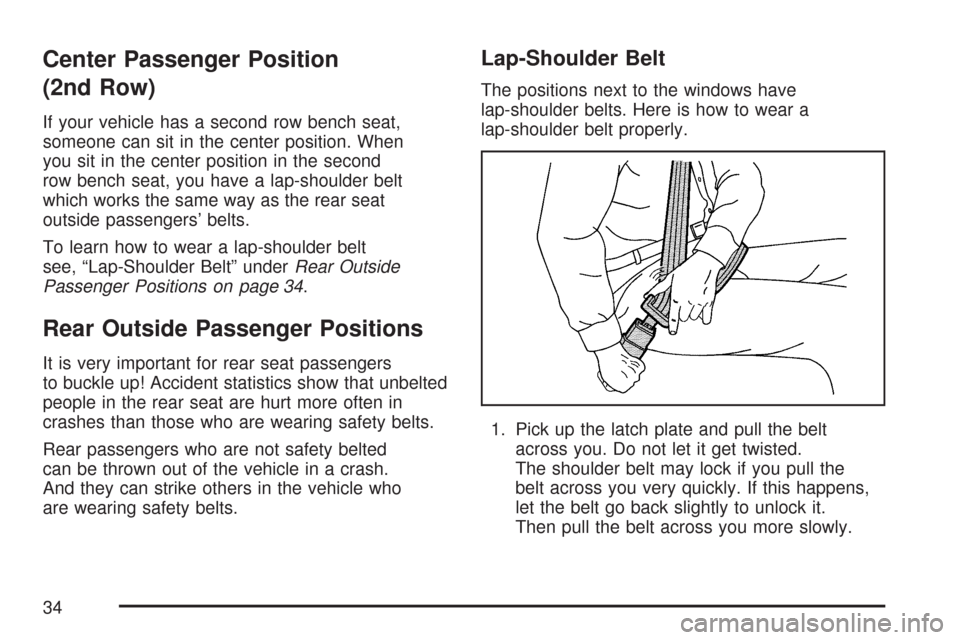
Center Passenger Position
(2nd Row)
If your vehicle has a second row bench seat,
someone can sit in the center position. When
you sit in the center position in the second
row bench seat, you have a lap-shoulder belt
which works the same way as the rear seat
outside passengers’ belts.
To learn how to wear a lap-shoulder belt
see, “Lap-Shoulder Belt” underRear Outside
Passenger Positions on page 34.
Rear Outside Passenger Positions
It is very important for rear seat passengers
to buckle up! Accident statistics show that unbelted
people in the rear seat are hurt more often in
crashes than those who are wearing safety belts.
Rear passengers who are not safety belted
can be thrown out of the vehicle in a crash.
And they can strike others in the vehicle who
are wearing safety belts.
Lap-Shoulder Belt
The positions next to the windows have
lap-shoulder belts. Here is how to wear a
lap-shoulder belt properly.
1. Pick up the latch plate and pull the belt
across you. Do not let it get twisted.
The shoulder belt may lock if you pull the
belt across you very quickly. If this happens,
let the belt go back slightly to unlock it.
Then pull the belt across you more slowly.
34
Page 52 of 458
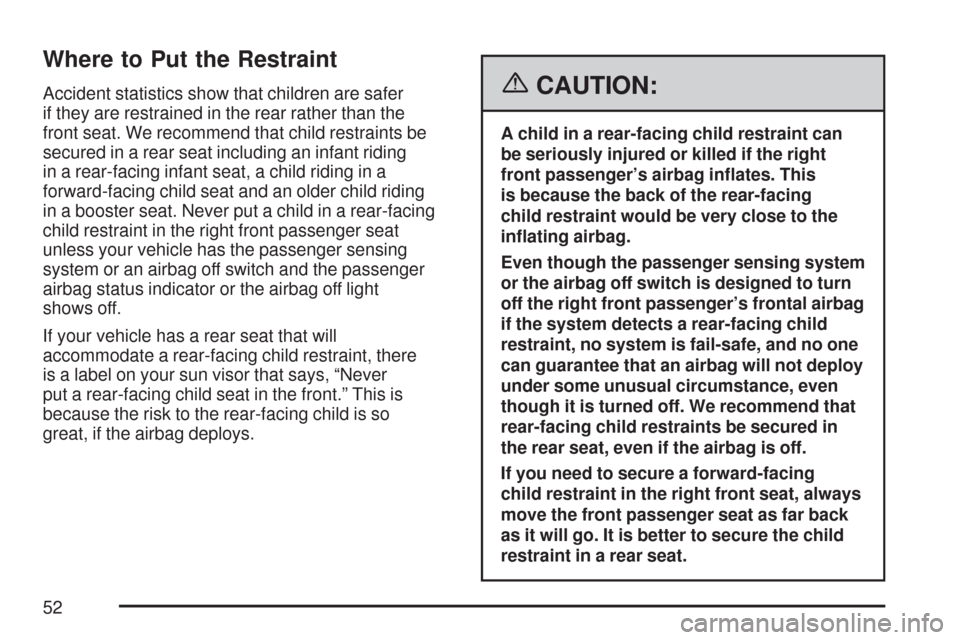
Where to Put the Restraint
Accident statistics show that children are safer
if they are restrained in the rear rather than the
front seat. We recommend that child restraints be
secured in a rear seat including an infant riding
in a rear-facing infant seat, a child riding in a
forward-facing child seat and an older child riding
in a booster seat. Never put a child in a rear-facing
child restraint in the right front passenger seat
unless your vehicle has the passenger sensing
system or an airbag off switch and the passenger
airbag status indicator or the airbag off light
shows off.
If your vehicle has a rear seat that will
accommodate a rear-facing child restraint, there
is a label on your sun visor that says, “Never
put a rear-facing child seat in the front.” This is
because the risk to the rear-facing child is so
great, if the airbag deploys.{CAUTION:
A child in a rear-facing child restraint can
be seriously injured or killed if the right
front passenger’s airbag in�ates. This
is because the back of the rear-facing
child restraint would be very close to the
in�ating airbag.
Even though the passenger sensing system
or the airbag off switch is designed to turn
off the right front passenger’s frontal airbag
if the system detects a rear-facing child
restraint, no system is fail-safe, and no one
can guarantee that an airbag will not deploy
under some unusual circumstance, even
though it is turned off. We recommend that
rear-facing child restraints be secured in
the rear seat, even if the airbag is off.
If you need to secure a forward-facing
child restraint in the right front seat, always
move the front passenger seat as far back
as it will go. It is better to secure the child
restraint in a rear seat.
52
Page 53 of 458
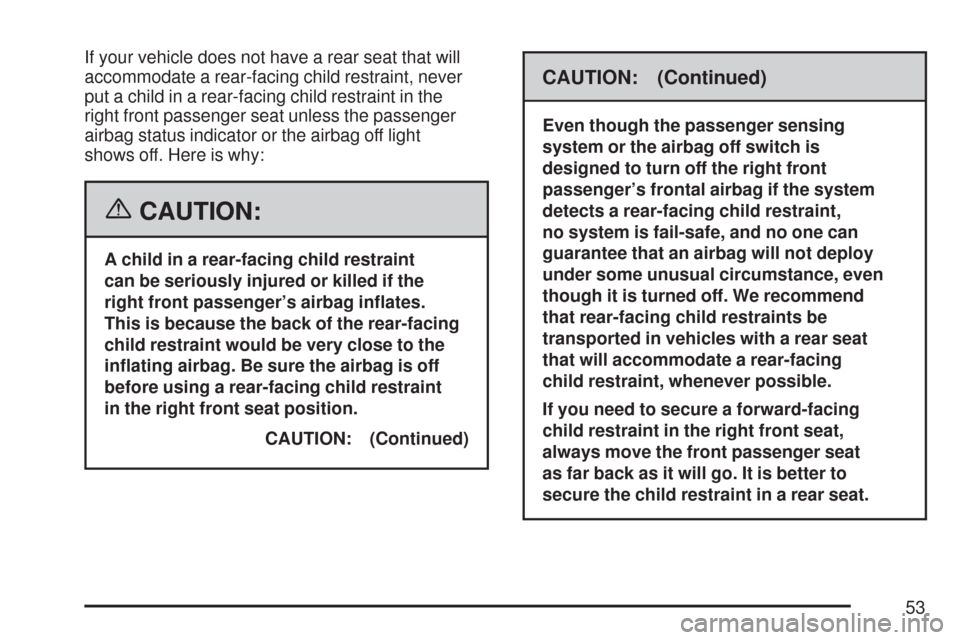
If your vehicle does not have a rear seat that will
accommodate a rear-facing child restraint, never
put a child in a rear-facing child restraint in the
right front passenger seat unless the passenger
airbag status indicator or the airbag off light
shows off. Here is why:
{CAUTION:
A child in a rear-facing child restraint
can be seriously injured or killed if the
right front passenger’s airbag in�ates.
This is because the back of the rear-facing
child restraint would be very close to the
in�ating airbag. Be sure the airbag is off
before using a rear-facing child restraint
in the right front seat position.
CAUTION: (Continued)
CAUTION: (Continued)
Even though the passenger sensing
system or the airbag off switch is
designed to turn off the right front
passenger’s frontal airbag if the system
detects a rear-facing child restraint,
no system is fail-safe, and no one can
guarantee that an airbag will not deploy
under some unusual circumstance, even
though it is turned off. We recommend
that rear-facing child restraints be
transported in vehicles with a rear seat
that will accommodate a rear-facing
child restraint, whenever possible.
If you need to secure a forward-facing
child restraint in the right front seat,
always move the front passenger seat
as far back as it will go. It is better to
secure the child restraint in a rear seat.
53
Page 70 of 458
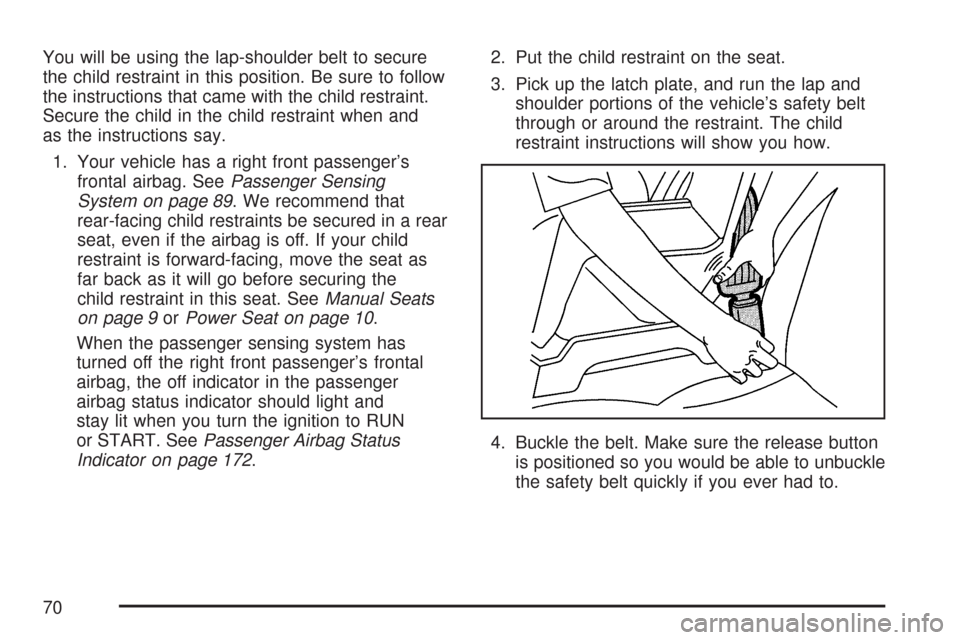
You will be using the lap-shoulder belt to secure
the child restraint in this position. Be sure to follow
the instructions that came with the child restraint.
Secure the child in the child restraint when and
as the instructions say.
1. Your vehicle has a right front passenger’s
frontal airbag. SeePassenger Sensing
System on page 89. We recommend that
rear-facing child restraints be secured in a rear
seat, even if the airbag is off. If your child
restraint is forward-facing, move the seat as
far back as it will go before securing the
child restraint in this seat. SeeManual Seats
on page 9orPower Seat on page 10.
When the passenger sensing system has
turned off the right front passenger’s frontal
airbag, the off indicator in the passenger
airbag status indicator should light and
stay lit when you turn the ignition to RUN
or START. SeePassenger Airbag Status
Indicator on page 172.2. Put the child restraint on the seat.
3. Pick up the latch plate, and run the lap and
shoulder portions of the vehicle’s safety belt
through or around the restraint. The child
restraint instructions will show you how.
4. Buckle the belt. Make sure the release button
is positioned so you would be able to unbuckle
the safety belt quickly if you ever had to.
70